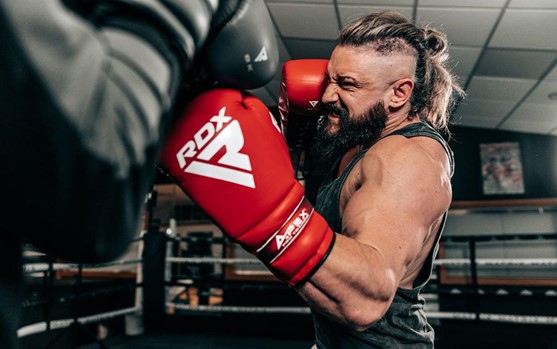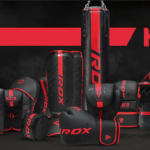Step into the boxing ring, my friend, and let us embark on a journey through the realm of pugilism, where warriors don their gloves and unleash a symphony of strength and finesse. Boxing, the noble art of combat, has captured the hearts and minds of enthusiasts for generations.
It is a sport that blends the poetry of movement with the sheer power of physicality. But have you ever stopped to ponder the intricate workings of the human body that lie beneath the surface of those sweat-soaked gloves and glistening muscles?
Beyond the thoughtful footwork and lightning-fast punches, boxing engages an array of muscles that work in harmony, like a well-rehearsed orchestra. The act of throwing a punch involves a chain reaction that begins with the force generated from the legs, travels through the core, and ultimately finds its culmination in the arms and fists. Every muscle group contributes its unique strength and plays a crucial role in delivering that knockout blow.
In this blog, we will discuss in detail the multiple groups of muscles used in boxing. So, get ready to uncover the hidden secrets that sculpt champions to conquer the squared realms!
How Does Boxing Help in Building Muscle?
Boxing is not only a dynamic sport but also a fantastic way to sculpt and build muscle. The physical demands of boxing require engaging and activating various muscle groups, leading to increased strength, endurance, and overall muscle development. Here is how it helps in building muscle:
Related Article: Ultimate Guide To Boxing Training
Full-Body Engagement
Boxing is a total-body workout that engages multiple muscle groups simultaneously. When you throw punches, your arms, shoulders, and chest muscles are actively involved in generating power and speed.
At the same time, your legs, hips, and core muscles work together to provide stability, and balance and generate the necessary force. This full-body engagement leads to muscle activation and growth throughout the entire body.
Resistance Training
Boxing involves repetitive movements against resistance. The resistance comes from the impact of punches, the weight of boxing gloves, and the resistance provided by punching bags or pads.
This resistance training stimulates muscle fibers, promoting muscle growth and increasing strength. The constant repetition of punching and defensive movements challenges your muscles, leading to muscular adaptation and growth over time.
Core Strength and Stability
The core muscles play a crucial role in boxing, providing stability and power transfer from the lower body to the upper body. As you throw punches and move around the ring, your core muscles, including the abdominals, obliques, and lower back, are constantly engaged to maintain balance, generate rotational force, and protect your body.
The intense core activation during boxing workouts helps strengthen and define these muscles.
Cardiovascular Endurance
Boxing is a high-intensity interval workout that involves rapid movements, explosive bursts of energy, and constant movement. The cardiovascular demands of boxing training elevate your heart rate, improving your cardiovascular endurance and promoting fat loss.
While boxing primarily targets muscles, the combination of strength training and cardiovascular exercise can lead to a toned, muscular physique.
A research comparing the effects of HIIT boxing training’s effect on cardiovascular outcomes to brisk walking concluded that boxing may have a better impact on individuals trying to improve their cardiovascular health and reduce obesity.
Improved Muscular Endurance
Boxing workouts often involve repetitive punching combinations, shadowboxing, and sparring sessions, which require muscular endurance. The repeated contractions and sustained effort of these activities train your muscles to endure prolonged exertion.
Research says that it improves your muscle endurance, allowing you to perform better and for longer durations.
Increased Power and Explosiveness
Boxing training focuses on developing explosive power, which is essential for delivering powerful punches and quick movements. Plyometric exercises, such as jumping rope, medicine ball exercises, and explosive punching drills, enhance your fast-twitch muscle fibers, responsible for explosive movements. These explosive movements help build muscle strength and power, contributing to a more athletic physique.
Total-Body Conditioning
Boxing workouts incorporate a wide range of exercises such as jumping jacks, burpees, push-ups, squats, and agility drills. These exercises target various muscle groups, including the arms, shoulders, chest, back, legs, and core.
By engaging in a comprehensive total-body conditioning regimen, you can develop balanced muscle growth and improve overall muscular strength and tone.
Now that we have discussed how boxing helps build muscles, let’s have a look at the different muscles that it targets.
Upper Body Muscles: Upper Back, Shoulders, Arms, Chest, Lower Back
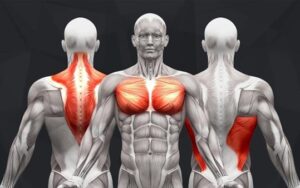
In the world of boxing, every punch, every movement requires a delicate balance of strength, coordination, and mobility. All upper body muscles in boxing play a unique role to play in boxing to ensure your punches are delivered with precision, power, and safety. It is important to focus on building strength, mobility, and stability in all these muscle groups to optimize your performance and minimize the risk of injuries.
Upper Back
When it comes to what muscles boxing work, upper back muscles are the first to hit the list. These muscles, including the latissimus dorsi, trapezius, and rhomboids, work tirelessly to stabilize and support your upper body during punches and defensive movements.
As you throw punches, your upper back muscles engage to maintain proper posture, ensuring that your shoulders are correctly aligned and providing a solid foundation for powerful strikes. They also significantly generate rotational force, enabling you to deliver devastating hooks and uppercuts.
Additionally, the upper back muscles contribute to shoulder retraction, allowing you to quickly retract your arms and prepare for the next punch. By strengthening and conditioning these muscles through boxing training, you enhance their endurance and power, reducing the risk of fatigue and injury.
A strong upper back not only improves your punching technique but also contributes to overall athleticism and stability in the ring.
Shoulders
With each punch you throw, your shoulders are the driving force behind the delivery of power and speed. The shoulder muscles, particularly the deltoids, play a vital role in stabilizing and mobilizing the upper arms during punches.
Whether it’s a jab, cross, hook, or uppercut, the shoulders initiate the movement and propel your fists forward. The anterior deltoid, located at the front of the shoulder, is primarily responsible for shoulder flexion, while the lateral deltoid, on the side of the shoulder, aids in shoulder abduction and rotation.
These muscles, along with the rotator cuff muscles, work in tandem to ensure smooth and controlled movements, generating the necessary force to land impactful punches. A study suggests that boxing training helps strengthen and develop the shoulder muscles, enhancing their endurance, stability, and overall strength.
Arms
Boxing targets the biceps and triceps, the dynamic duo responsible for flexing and extending your elbows during punches.
The biceps, located on the front of the upper arm, are responsible for flexing the elbow joint and generating power during punches. The biceps contract forcefully with each jab, cross, or hook, propelling your fist forward with precision and speed.
On the other hand, triceps training is just as crucial. Situated on the back of the upper arm, they play a vital role in extending the elbow. They are particularly engaged during the extension phase of a punch, allowing for quick retraction and readiness for the next strike.
Through the repetitive motion of punching, your arm muscles undergo constant activation and exertion, leading to muscle growth, strength, and toning. Over time, regular boxing training will sculpt and define your arms, giving them a powerful and athletic appearance.
Related Article: Arm Workout To Build Pulsating Biceps
Chest
As you throw punches, your pectoral muscles come into play, providing stability and assisting in generating force.
The chest muscles, specifically the pectoralis major and pectoralis minor, provide the foundation and support necessary for generating force in your punches. As you throw punches, the pectoral muscles contract, assisting in shoulder flexion and horizontal adduction and contributing to the forward propulsion of your fists.
The activation of these muscles adds strength and power to your punches, allowing you to strike with impact. Furthermore, a well-developed chest provides stability and balance, preventing excessive movement and maintaining proper posture throughout your boxing movements.
Lower Back
While boxing primarily focuses on the upper body, it also engages and strengthens the muscles of the lower back. The lower back muscles, including the erector spinae and multifidus, play a crucial role in maintaining proper posture, stability, and power transfer during boxing movements.
Your lower back muscles work in synergy with the rest of your core to provide a solid foundation and support for your upper body. They help stabilize the spine and pelvis, allowing for efficient transfer of force from the lower body to the upper body.
According to a study published in 2011, boxers use their lower back muscles less than they should. This means that as a boxer, it is important to drive through the lower back muscles in order to pack a more powerful punch.
Strengthening your lower back not only improves your boxing performance but also promotes overall spinal health and reduces the risk of lower back injuries.
The Core Muscles
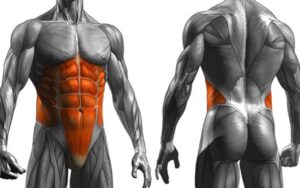
Your core muscles, including the abdominals, obliques, and lower back, play a pivotal role in generating power, maintaining balance, and protecting your body during boxing movements.
Boxing defines abs with every punch. It allows the core muscles to engage to provide a solid foundation and transfer force from the lower body to the upper body, enabling powerful strikes. They also contribute to rotational movements, allowing you to generate torque and deliver devastating hooks and uppercuts.
Additionally, your core acts as a stabilizer, helping to maintain proper posture, preventing excessive movement, and reducing the risk of injury. The constant engagement of your core muscles in boxing training strengthens these muscles, leading to improved stability, endurance, and overall core strength.
Related Article: Core Strength And Punching Power Training
Lower Body Muscles: Glutes, Quads, Hamstrings, Calves
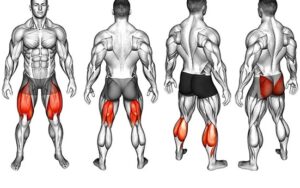
When we talk about the muscles worked during boxing, it’s not just about the upper body. While the lower body may not be the star of the show, it still has a crucial role to play in the world of boxing.
While used to a lesser extent, the lower body muscles ensure that your upper body can perform its explosive punches with finesse and precision.
Glutes
As you engage in boxing, your glutes act as stabilizers, providing a solid foundation for your lower body movements. They work in tandem with your core and lower back muscles to maintain proper posture and balance, ensuring that your punches are delivered with maximum force and accuracy.
Additionally, the glutes contribute to hip extension, which is a key component of generating power in your punches. Whether it’s a powerful cross or a devastating uppercut, the explosive movement starts from the ground up, with your glutes firing to drive the force through your hips and into your fists.
Regular boxing training not only strengthens your glutes but also improves their endurance, stability, and power. Strong glutes contribute to overall lower body strength and athleticism, enhancing your performance in the ring.
Quads
Boxing engages the quadriceps, a group of powerful muscles situated at the front of the thighs, to deliver forceful punches. The quadriceps play a pivotal role in generating lower body strength, which is fundamental to optimal performance in the sport.
During the execution of punches, the quadriceps actively contribute to the kinetic chain of the lower body. Working in synergy with the glutes, hamstrings, and calves, they participate in the force generation required for rapid and forceful movements.
By extending the knee joint, the quadriceps enable the transfer of weight and the generation of forward momentum, which are essential components of powerful punches.
Related Article: Quintessential Quads – Leg Day Workout Variations To Define Your Thighs
Hamstrings
During the execution of punches, the hamstrings transfer the power from the lower body to the upper body. As boxers push off the ground and rotate their hips, the hamstrings contract, assisting in the extension of the hip joint. This coordinated action allows for the generation of force, enhancing the speed and power of punches.
Furthermore, the hamstrings act as stabilizers during boxing movements, supporting proper alignment and balance. They work in conjunction with other muscles of the lower body, such as the quadriceps and glutes, to maintain a stable base and absorb external forces. This stability is crucial in executing swift footwork, evading opponent strikes, and maintaining optimal positioning in the ring.
The dynamic nature of the sport, involving constant movement, pivoting, and explosive actions, places consistent demands on these muscles. As a result, the hamstrings undergo adaptation, gaining strength, endurance, and resilience over time.
By incorporating specific exercises and training protocols targeting the hamstrings, boxers can enhance their overall athleticism and maximize their potential within the ring.
Calves
The calves, comprising the powerful gastrocnemius and soleus muscles, play a crucial role in facilitating movement and contributing to overall performance. These muscles, located at the back of the lower leg, are actively engaged in generating force and providing stability during various boxing actions.
As boxers maneuver around the ring, the calves contract to propel the body forward, backward, and laterally. They provide the necessary push-off power from the ground, enabling swift changes in direction, creating angles for punches, and evading opponent attacks.
The fast-paced nature of the sport places significant demands on these muscles. Through repeated actions, including jumping, pivoting, and quick direction changes, the calves undergo adaptation, developing strength, endurance, and resilience over time.
Conclusion
In conclusion, boxing is a captivating sport that engages various muscle groups throughout the body, from the upper body to the lower body. Regular boxing training not only strengthens and conditions these muscles but also improves their endurance and ability to withstand the demands of the sport.
Developing a well-rounded physique and functional strength throughout the body is essential for boxers to maximize their performance, minimize the risk of injuries, and achieve success in the ring. It’s also important to make the right use of protective gear in boxing to ensure utmost safety along with the proper technique.
In the world of boxing, it’s not just about throwing punches. It’s about mastering the symphony of muscles, working together to create a powerful, controlled, and safe boxing experience. So, get ready to embrace the challenge, train smart, and unleash the true potential of your body in the captivating realm of boxing.

